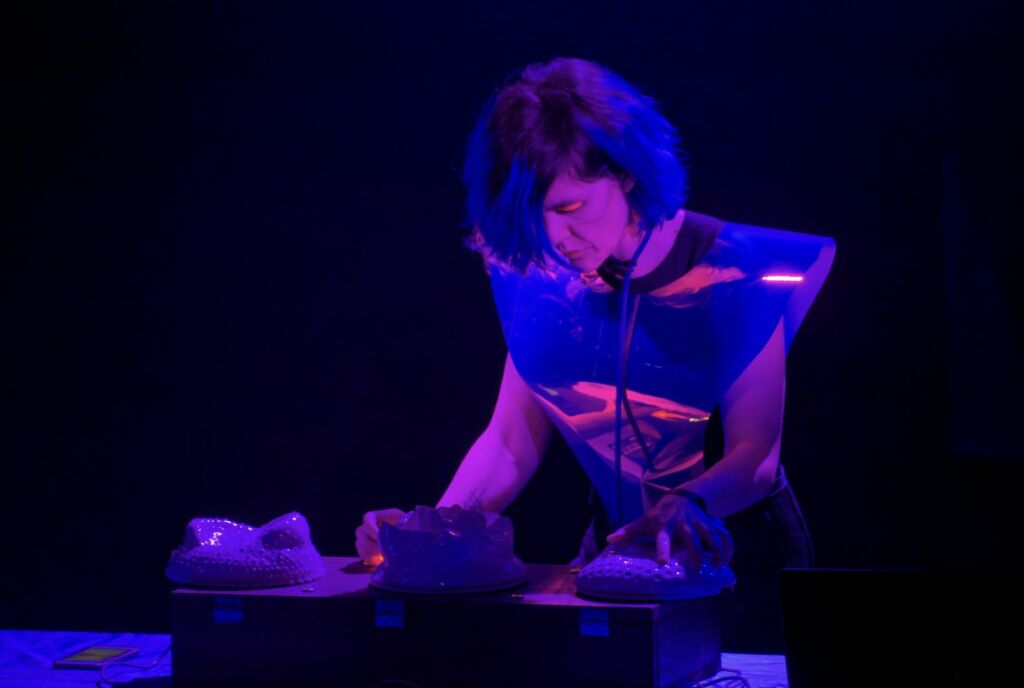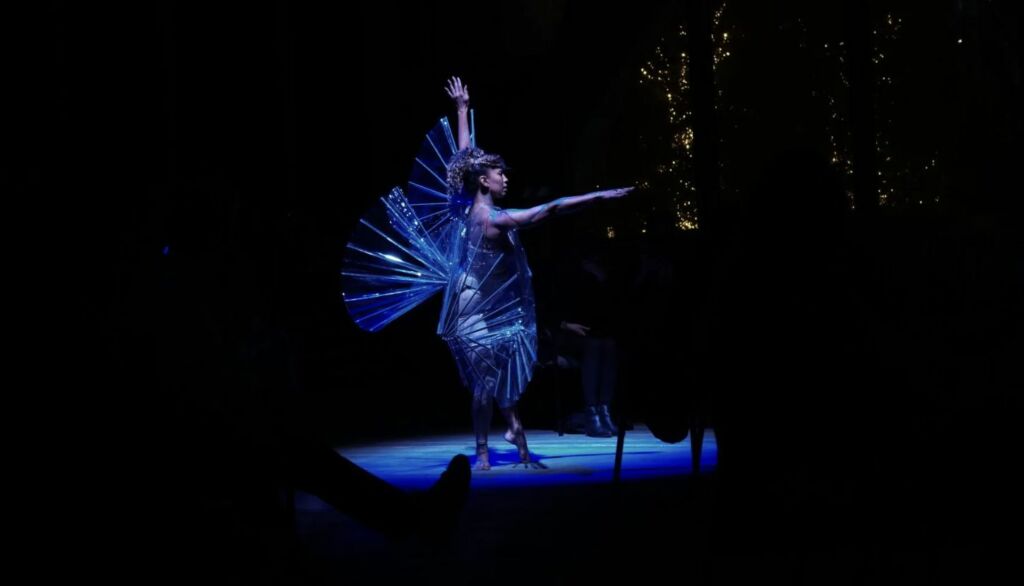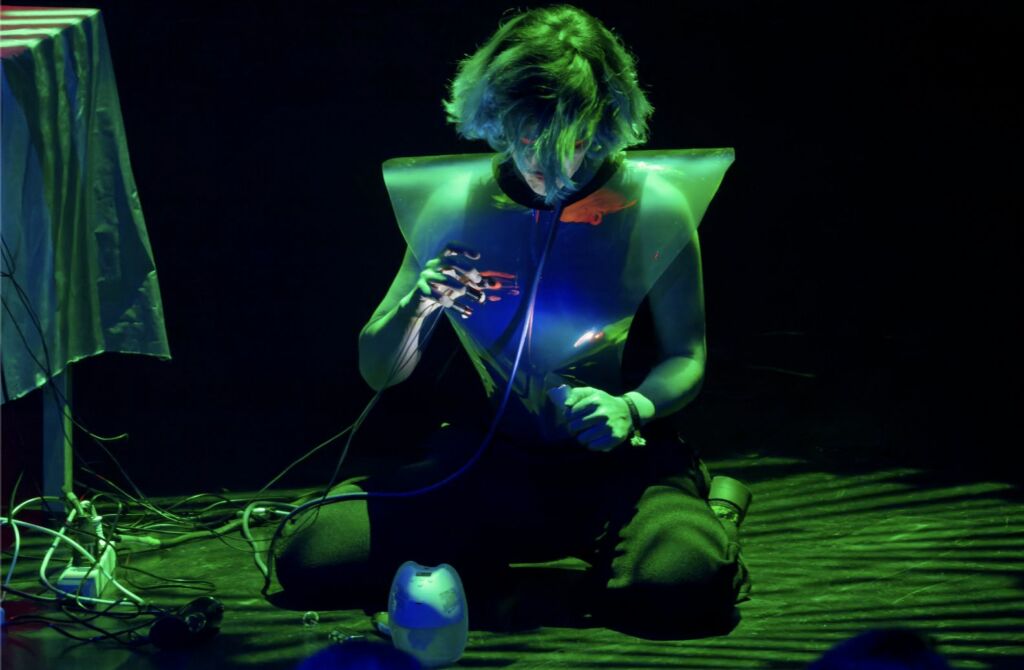Interview by Olya Karlovich

It all started with improvisation. When 20-year-old Merche Blasco was looking for a hobby to switch off from studies in communication engineering, at least for some time, a friend took her to an audition for a punk band. ‘Just sing something, anything,’ the band members suggested, starting to play one of their songs, which Blasco had never heard before. She was surprised and confused but accomplished the task, improvising a melody and making gibberish words on the fly. That experience was a turning point. ‘I realised that I can come up with melodies and sounds,’ the artist recalls.
Today Merche Blasco not only creates music spontaneously and without preparation but also has her own approach to improvisation, according to which listening at different levels and not only with your ears is a determinative action. Working with performance, she opens spaces of collective experience where all elements, whether human nature or not, are interconnected, and the relationship between them loses its vertical hierarchy.
After moving away from using commercial machines, Blasco focused on building custom instruments and reimagining our interaction with technology. Her unique devices are designed to make it impossible to predict the outcome — they bring chaos and surprise to the process, and their beauty is imperfection. Thus, the performance is more like a real-time exploration, where even the most delicate Blasco’s gestures and body movements directly affect the sound and vice versa.
Along with solo projects, collaborative ones also play a big role in the artist’s practice. For example, in a three-act show, Vibrant Strata, alongside guest performers, Blasco interacted with the electromagnetic field of the building through unique homemade devices, amplifying the vibrations of the animate and inanimate worlds and exploring the energies that connect us to each other and to the external environment. What also makes such complex improvisations so special is the involvement of each participant in the creative process. And you also see it in Blasco’s participatory performances, where the audience’s actions are an integral part of the composition. A good example here is BLINK, during which several dozen cyclists created a symphony of bicycle bells guided by the artist’s light instructions.
Having gone through an impressive path of creative transformations — from a singer in rock bands to the creation of her previous project Burbuja and, finally, the development of technological assemblages, Blasco always remains faithful to one of her artistic expressions, field recordings. The artist integrates them into her performances and uses them as a compositional tool. For example, in her recent piece Travesía, she combined the sounds of defensive bunkers in the Spanish Pyrenees with recordings of peaceful nature beyond their walls.
After receiving a DAAD Fellowship in 2022, Blasco moved from New York to Berlin, where she presented the live improvisation FAUNA at the CTM Festival in February. A week after the concert, I called the artist to talk about her approach to performance and composition, her relationship with technology, and the loss of control in the creative process.


For those unfamiliar with your work, can you explain your decision to reconsider your process and area of interest, moving from making electronic and electro-acoustic music with commercial tools to developing your unique technological assemblages and exploring alternative forms of performance?
That was a combination of various factors and the need to expand my improvisational practice as a musician. I made experimental electronics in my previous project, but my process was very traditional — composing songs and then releasing them. And at one point, it became frustrating. The more I toured, the more restricted I felt with my tools. The technologies very much imposed on the way I had to perform and the sounds I was creating. Thinking a lot about what to activate or follow next, I stopped being present on the stage. I still enjoyed the composition process — recording and manipulating some sounds. But the performance itself was meaningless; I no longer listened to it.
Looking at the problem, I started to explore, which was a part of my PhD in composition as well, different threads in the history of audio technology design that have led us to the situation where, since the first music studios, we have been inheriting the technologies heavily encoded with ideas of power, control, productivity and efficiency. These machines are also used for purposes like warfare and military operations. And this is not what I wanted to reflect in my music and sound. So that was the initial trigger. I thought, let’s build other machines and see where it goes.
Why is performance the best medium for achieving your creative goals? What are the exceptional possibilities it offers you as an artist?
The energy in the space generated in a live performance situation is one of the most transcendent and powerful experiences. It doesn’t matter whether I am attending or performing myself. So when the pandemic hit, some of my attempts at online performance didn’t work. But, because it is so important to be in one space and have all these bodies being traversed by the sounds in a way, we are all connected.
It was at CTM when I saw you performing live for the first time. But I watched a few videos from other shows you’d had in different locations. How do you usually modify your performance/piece to fit the space and the context in which it is presented? What is the creative process behind this?
It is always the question of the time you can spend with a space, which is usually less in the context of a festival. For performances like ‘FAUNA,’ visiting a venue beforehand and listening to a sound system, I always think of how to offer the audience the best possible experience. For example, at CTM, I performed in a big theatre and expected some people to sit far away from me and at the table with instruments. But it was important [that the audience] understand or question how the sound was being produced, which has a lot to do with my interaction with the instruments and materials. So I asked for a live camera that projected close-ups of what was happening.
I also adjusted each movement of the performance. In ‘FAUNA’, there are three of them. The first one is a lot about vibrating the space and its bodies. And when I rehearsed that part in my house, all the furniture responded. So I experimented with sorts of low frequencies, and they vibrated the lamp above my head or table and different fixtures around the room. I wanted to repeat that at CTM, but the festival venue was radically different. I had to crack my levels up to the max, but still, it wasn’t the same experience, even compared to the soundcheck, because of how all the bodies in space absorbed the vibrations. These circumstances are constantly changing, and I try to adapt to them and talk to the space, exploring how it can vibrate or move and how the audience will feel it in different parts of their bodies.
In the second ‘FAUNA’ movement, I interact with domestic appliances or use discarded electronics from my house. For example, this time, it was a broken blender and a breast pump that hadn’t appeared in previous performances.
And finally, the last part, where I use field recordings, is always an ongoing process. I do recordings and then test them with my instruments to see what can be incorporated. So yes, there is always some evolution. And I always try to make my pieces site-specific.
Working with custom-built instruments, you probably can’t 100% predict the outcome. And It seems like not only ‘FAUNA’ but your practice, in general, is about the ongoing process and transformations; you are always redefining something through your performances. Can you elaborate a bit more on this?
What you have just said about being unable to control the instruments is very important and embedded in their design. So getting away from commercial hardware, I try to create tools that will leave me in a place I don’t know in advance and cannot predict and control. Because otherwise, the practice is meaningless.
There is constant feedback between performing and listening to what is happening. And then the hardware, software and sound design, everything is changing [through this process]. So all the instruments are causally involved. For example, the first device I performed at CTM has two skins. The first was made of ceramics. I wanted to build an instrument to dive into the acoustics effect called ‘beat’. And the thing is that it happens with a tiny shift in the frequencies of two sine waves, so I had to work with a material that requires very delicate interactions and small moves. And I treat ceramic very delicately.
But after performing with this instrument for a while, I also missed all the other types of gesturality, which is why I created the second skin. After the first part of ‘FAUNA,’ I removed the ceramic orbs, so you saw the evolution of the instrument. The next iteration looks like a DJ table with three disks. Expanding on this image, I created three acrylic disks instead of ceramic pieces using the same sensors and then changed the whole sound design. The three records on the table became field recordings, and my gestures are different as I work with them.
This is an example of how gesturality can lead me somewhere else and what the sound should be like If I interact with different materials. And in all the pieces, through listening, I realise that there are new sonic inspirations. And it leads to improvisation and changes. The more I perform with my instruments, the more happy accidents can be incorporated.
And how do you listen during a performance? Can you describe your approach to this process?
Yeah, it’s all about listening — not just with my ears but with the whole body. For example, the ceramic orbs or another instrument, ‘Espongina’, involve a lot of live exploration of materials. The sensors read the disturbance created by my hands and then transform them into sounds. And it is a constant process throughout the performance: I explore the material with my fingers, which creates and changes the sound I listen to. So this includes listening at different levels.
Something mesmerising was about your gestures and body movements during the CTM performance. You looked both focused and relaxed. Please elaborate more on this state you were trying to enter through interaction with the instruments. What does it mean to you as an artist/performer to ‘distance yourself from the parameters of precision, power, and control’?
I was a singer in different rock and punk bands when I started being involved in music. And after moving to technology, I always missed that energy. It was so liberating how we were lying on the floor or kicking each other, all these things. But when you are behind the computer with a static body, it is completely lost.
I tried to balance that in my previous project by including visuals and many other things. But it only helped a little because, as I mentioned, the music produced with commercial hardware followed parameters of control and efficiency, so I was the least dynamic element on stage. My new custom instruments will allow me to explore more. They are embedded with failure, imprecision and chaos, and they force me to listen.
And the state I am trying to enter is really about being present. Because what you do on stage will change the outcome and affect the performance. I am not just pressing play; the machine is going by itself. So again, you have to listen.
The CTM performance was very challenging because I wasn’t experiencing the same sound system you were as an audience. I just had a monitor, and that separation made it tricky. I was struggling with that, so that may be why my face was a bit extra focused.
Let’s talk about your compositional approach. How would you describe what type of composer Merche Blasco is?
The performances like ‘FAUNA’ are always improvisation. There is a structure, but it is more like an arc of experience that I define in rehearsal. And what happens within it is a live improvisation.
But in general, composition is part of a process. And If I compose for an ensemble or other musicians, they should be involved. For example, we can establish an open workshop, and the result of it will always be an abstract score in the form of drawings or available instructions. And musicians can follow those instructions in their way to perform. It has to be an exchange. I need to interact with other voices of creativity during a performance.
But when the pandemic hit, I got into composing more because it was the only way to create and share sounds. For example, I just released a tape with field recordings and electronics made in 2021 in the Spanish Pyrenees. But even with this type of composition, I would conduct a performance experiment for myself. I recorded improvisations for sections of the piece and then edited the final result [into a composition].
I also do participatory performances, which are open processes. And I like to work this way. Once, I did a score for traffic patterns. [The determining factor in it] was the traffic going down under the overpass where the audience and I were all standing. But in addition to that, everything else happening in the performative space, how people were listening to it, was a living exploration. So it is never a closed composition.
Back to your devices, some of them (for instance, the ceramic orbs you used in ‘FAUNA’ or ‘Espongina’) sound fascinating and good-looking. Was it an intention? What other things are important to you when building a new instrument? And how do you find a balance between sound, design, and tactile experience during this process?
It depends on the instrument. First, there was an impulse to escape from cold and clinical materials of commercial tools like metal or silicon. The materials I am looking for are imperfect in a way that their materiality becomes a part of the score. They can create different outputs in terms of sound.
For example, the building of ‘Espongina’ was triggered by an interest in the behaviour of water and its physical nature. What will happen to composition if I translate the momentum of water, which occurs when you start interacting with it, into sound? The sensor I used in this instrument measures vibrations transmitted from the moving water and the material containing it. Thus, the interaction with that material also would affect the sound. Realising this, I began to look for containers and objects to touch that would immediately call for live explorations with my hands and fingers.
Another of my instruments, a 3D printer called Anette, is also an expansion of that idea. To listen to her body, I use the same microphones [which enable us to hear the machine’s electromagnetic voice] presented in the second ‘FAUNA’ movement at CTM. How Anette is shaped, and her anatomy became a score for the piece. It sounds different depending on where I put my fingers — next to the extruder or somewhere else. Thus, the physicality of all these objects is very much linked to the compositional aspect.
How would you depict the relationship between your performative work on the one hand and your sound/engineering (when it comes to devising and designing new devices) research on the other hand?
It is hard to distinguish. It is all mixed and related to your question about redesigning the process. I don’t know when I am listening as an engineer or composer. And although the telecommunications engineering I studied has nothing to do with what my current practice requires (what I do with hardware design and sound now is very much self-taught), my background helps somehow. For example, I apply the knowledge of modularity in coding to instrument design. Again, however, I don’t know what is coming from which part of my brain.
What’s next for you in general and within your DAAD fellowship?
As part of my DAAD, I will collaborate with another colleague, Nandita Kumar, performing at MaerzMusik Festival with her project Paradigm To Paradigm.
I am also about to release another record, my collaboration with Lucie Vítková, which started with a live performance. Lucie performed with the accordion and synths, and I interacted with the 3D printer Annete. And I am starting to work on a three-act piece that will be my main project developed under the DAAD.
What’s your chief enemy of creativity?
Control. For example, during rehearsals for CTM, I tried to note some data coming from my instruments. They had a good outcome in terms of sound and wanted to reproduce them in the performance. But at one point, it felt like I was digging a hole for myself. Every time I try to control the situation somehow — because, for example, I am nervous and want to feel safe — I stop living the process.
You couldn’t live without…
Well, any serious answer feels a little bit lame. So, I am just going to say cheese.






